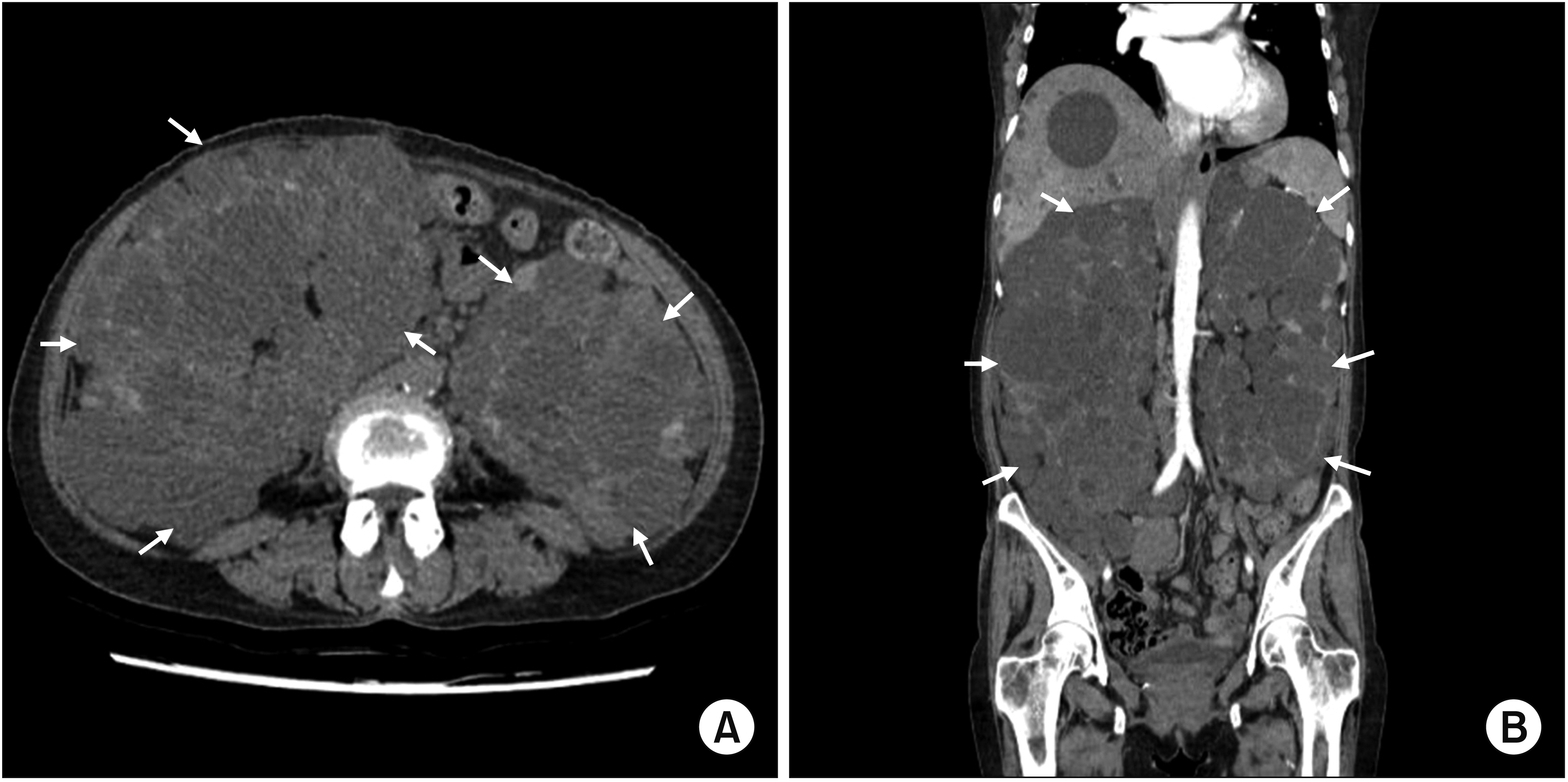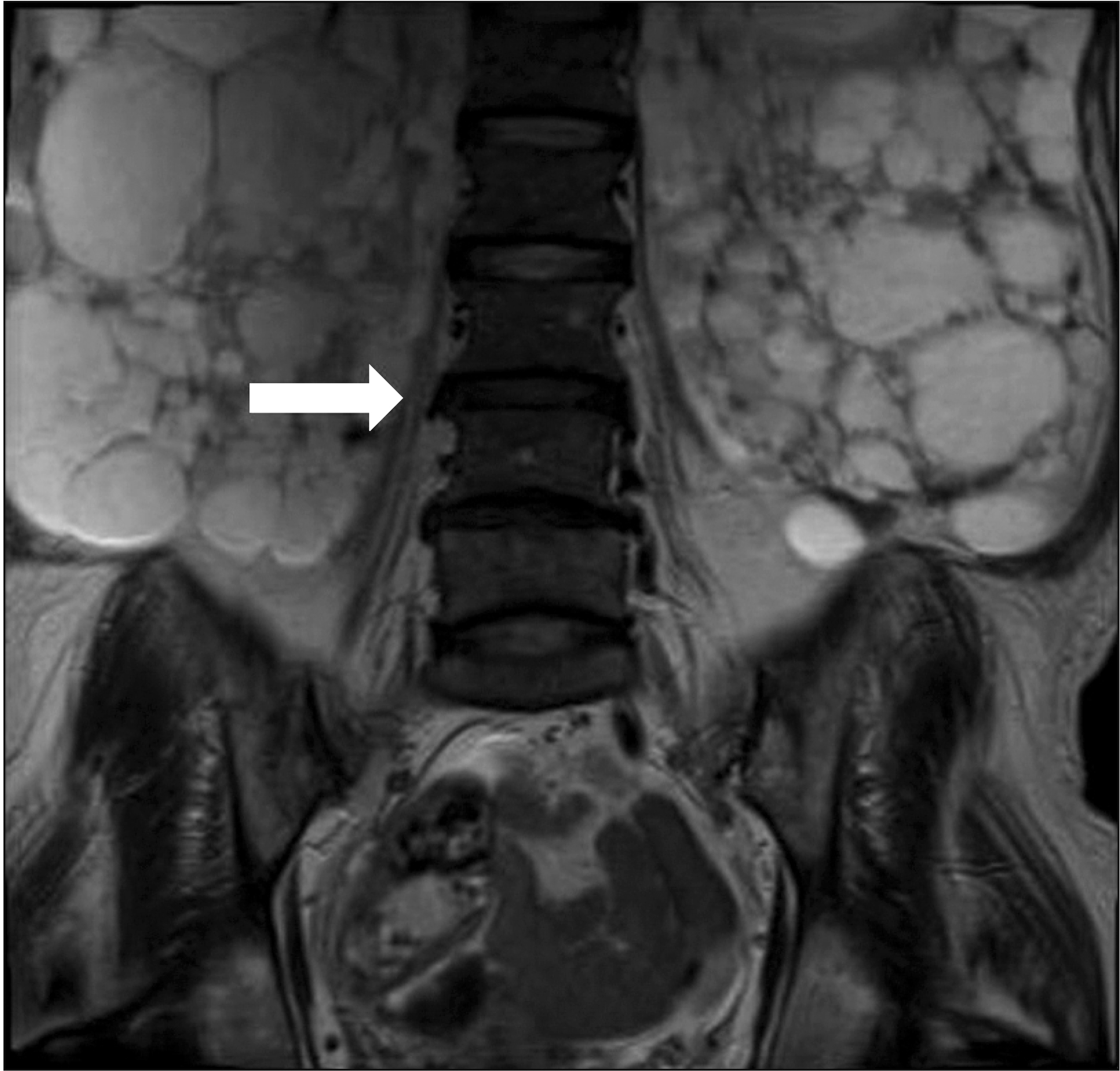Ann Rehabil Med.
2018 Jun;42(3):488-493. 10.5535/arm.2018.42.3.488.
Femoral Neuropathy Secondary to Autosomal Dominant Polycystic Kidney Disease: A Case Report
- Affiliations
-
- 1Department of Physical Medicine and Rehabilitation, Inje University Ilsan Paik Hospital, Goyang, Korea. stevejkang@gmail.com
- KMID: 2417843
- DOI: http://doi.org/10.5535/arm.2018.42.3.488
Abstract
- Compressive femoral neuropathy is a disabling condition accompanied by difficulty in hip flexion and knee extension. It may result from retroperitoneal hematoma or bleeding, or from complications associated with pelvic, hip surgery, and renal transplants. A 55-year-old female with autosomal dominant polycystic kidney disease presented with proximal muscle weakness in lower extremities. The patient experienced recurrent renal cyst infection, with aggravated weakness during each event. Electromyography and nerve conduction study revealed bilateral femoral neuropathy. Computed tomography and magnetic resonance images were added to further identify the cause. As a result, a diagnosis of femoral neuropathy caused by enlarged polycystic kidney was made. Cyst infection was managed with antibiotics. Renal function was maintained by frequent regular hemodialysis. While avoiding activities that may increase abdominal pressure, rehabilitation exercises were provided. Motor strength in hip flexion and knee extension improved, and was confirmed via electrodiagnostic studies.
MeSH Terms
Figure
Reference
-
1. Kumar S, Pflueger G. Delayed femoral nerve palsy associated with iliopsoas hematoma after primary total hip arthroplasty. Case Rep Orthop. 2016; 2016:6963542.
Article2. Ho KJ, Gawley SD, Young MR. Psoas haematoma and femoral neuropathy associated with enoxaparin therapy. Int J Clin Pract. 2003; 57:553–4.3. Lange B, Langer C, Markus PM, Becker H. Paralysis of the femoral nerve following totally extraperitoneal laparascopic inguinal hernia repair. Surg Endosc. 2003; 17:1157.
Article4. Sharma KR, Cross J, Santiago F, Ayyar DR, Burke G. Incidence of acute femoral neuropathy following renal transplantation. Arch Neurol. 2002; 59:541–5.
Article5. Hsu YC, Shih YY, Gao HW, Huang GS. Intramuscular schwannoma arising from the psoas muscle presenting with femoral nerve neuropathy. South Med J. 2010; 103:477–9.
Article6. Mendes DG, Nawalkar RR, Eldar S. Post-irradiation femoral neuropathy: a case report. J Bone Joint Surg Am. 1991; 73:137–40.
Article7. Huang WS, Lin PY, Yeh CH, Chin CC, Hsieh CC, Wang JY. Iatrogenic femoral neuropathy following pelvic surgery: a rare and often overlooked complication--four case reports and literature review. Chang Gung Med J. 2007; 30:374–9.8. Ekser B, Rigotti P. Images in clinical medicine: autosomal dominant polycystic kidney disease. N Engl J Med. 2010; 363:71.9. Carels RA, van Bommel EF. Ruptured giant liver cyst: a rare cause of acute abdomen in a haemodialysis patient with autosomal dominant polycystic kidney disease. Neth J Med. 2002; 60:363–5.10. Chapman AB, Stepniakowski K, Rahbari-Oskoui F. Hypertension in autosomal dominant polycystic kidney disease. Adv Chronic Kidney Dis. 2010; 17:153–63.
Article
- Full Text Links
- Actions
-
Cited
- CITED
-
- Close
- Share
- Similar articles
-
- A Case of Renal Cell Carcinoma in Autosomal Dominant Polycystic Kidney Disease Hemodialyzed
- Segmental Cystic Disease of the Kidney: A Case Report
- Autosomal Dominant Polycystic Kidney Desease Coexisting with Renal Dysplasia. First Case Described and Followed Since Prenatal Period
- A Case of Transitional Cell Carcinoma Associated with Adult Polycystic Kidney Disease
- A Case Report: Prenatal Ultrasonographic Diagnosis of Autosomal Dominant Polycystic Kidney Disease



